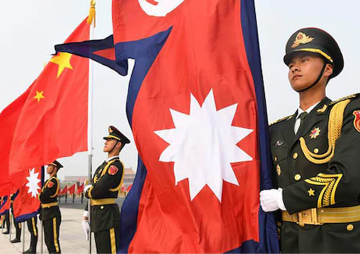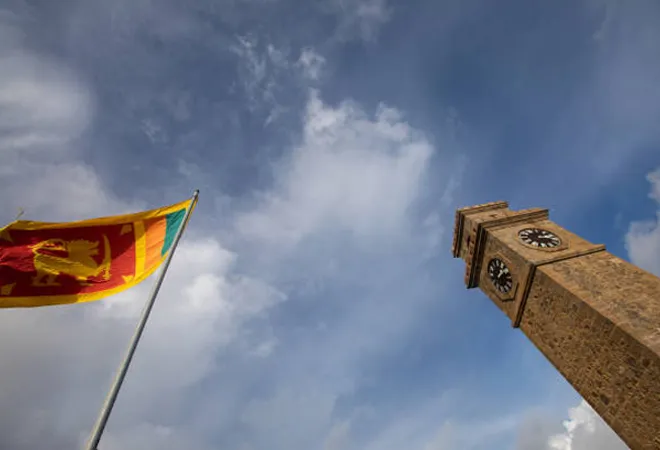
The Italian explorer Marco Polo’s claim that Sri Lanka was the "best island of its size in the world" dates back to the 12th century AD. The country’s tourism sector has grown over time to emerge as one of the most valuable players in the Sri Lankan economy, by heavily contributing towards employment generation, FOREX earnings as well as ensuring a steady supply of revenue for the successive governments in direct and indirect ways. Tourism in Sri Lanka accounts for almost 12 percent of the country's GDP and is the third-largest source of foreign exchange reserves—behind worker remittances and the apparel industry. However, the 2019 Easter Sunday Bombings marked the beginning of the collapse of this industry. This was followed by the double-whammy of the COVID-19 pandemic and the Ukraine–Russia conflict amidst the current economic crisis in Sri Lanka—undoubtedly making the revival of this sector extremely challenging.
Often labelled as Sri Lanka’s ‘Engine of Growth’, it was not until the 1960’s that the tourism sector in the country gained prominence with progressive steps to enhance the tourism infrastructure in terms of roads, airlines, and construction of new hotels. In fact, large-scale investment was also secured for bolstering the tourism industry with the liberalisation of the Sri Lankan economy in the late 1970s. However, the 26-years-long civil unrest in Sri Lanka that ended in 2009, followed by the fallouts of the Global Financial Crisis (2007-08) had a detrimental impact on the nation, deteriorating the tourism industry as well. It was only after 2010 that this sector saw a steep growth (see figure 1), proving itself to be one of the ace industries in the broader economic structure.
Figure 1: Tourist Arrivals and Earnings in Sri Lanka (2000-2021)
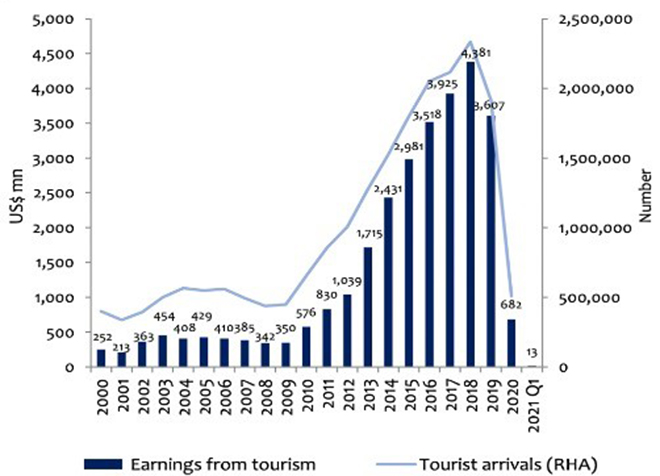 Source: Central Bank of Sri Lanka and SLTDA
Source: Central Bank of Sri Lanka and SLTDA
Sri Lanka’s tourism sector also contributes to direct and indirect employment of Sri Lankans, which has been steadily rising over the last few years until the pandemic hit (see figure 2). The total employment provided by this sector stood at approximately 403,000 in 2019. The devastation piled upon the country’s tourism sector and associated channels due to the current economic debacle, as well as the interplay of the other exogenous macroeconomic factors, is bound to have an alarming impact on Sri Lanka’s unemployment situation.
Figure 2: Employment generated by Sri Lanka’s Tourism Sector
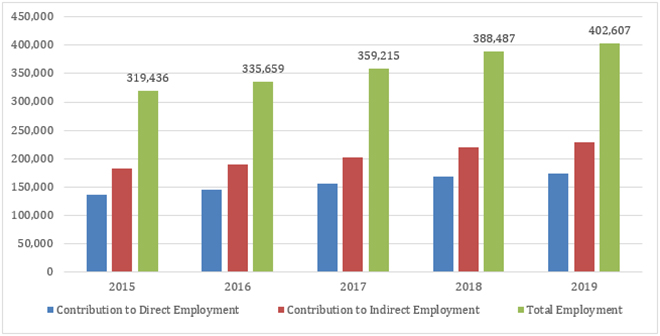 Source: Author’s own, data from Thushanga and Piyada (2021)
Source: Author’s own, data from Thushanga and Piyada (2021)
The country faced a horrific terrorist incident in April 2019, when the Easter Sunday Bombings in the national capital of Colombo, resulted in the deaths of 250 people, of which 42 were foreign nationals travelling to Sri Lanka. Many of the establishments across Sri Lanka were forced to pull down their shutters for days in the aftermath of the incident. Other countries were hasty in putting out travel advisories that warned their citizens to not travel to the island nation. Tourists exited the nation in large numbers, and the number of visitors fell by more than 70 percent in May and over 60 percent in June compared to the same months in the previous year (see figure 3).
In 2018, tourism provided US$ 4.4 billion in earnings to the Sri Lankan economy and contributed to 5.6 percent of the nation’s GDP, but this estimate came down to a paltry 0.8 percent in 2020, the year when the COVID-19 pandemic began to wreak havoc across the world with Sri Lanka turning out to be no exception (see figure 1 and 3). The onset of the pandemic also led to a 50 percent revenue drop in 2020, and a consequent fall in the tourist numbers, as per the Sri Lanka Tourism Development Authority (SLTDA). Adding to the woes, the loss of tourists from China and the European countries, some of the biggest markets for Sri Lanka’s already distressed tourism sector, came as a major blow.
Figure 3: Sri Lanka’s Tourist Numbers in 2019 and 2020
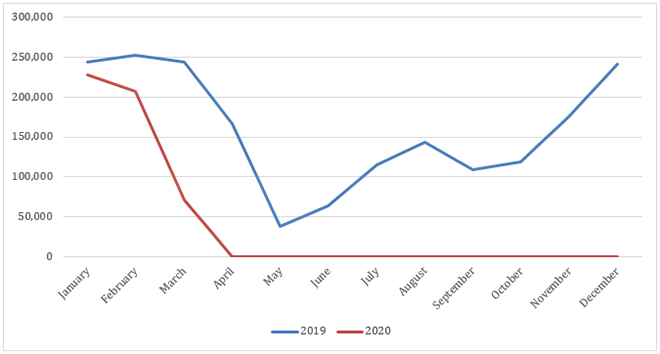 Source: Author’s own, data from Thushanga and Piyada (2021)
Source: Author’s own, data from Thushanga and Piyada (2021)
Making matters worse for the Sri Lankan economy is the ongoing Russia–Ukraine conflict which started in early 2022 and has crippled the tourism sector of Sri Lanka further. Russia and Ukraine, the top and third-largest tourist markets this year respectively, have played a crucial role in this domain. Nearly 20,000 tourists from Russia and Ukraine have travelled to Sri Lanka in January 2022, accounting for more than a quarter of all visitors; while the same made up for less than 10 percent of the tourist influx back in January 2018. The likes of Russia, Ukraine, Poland, and Belarus provided for nearly 30 percent of tourists before 2022 and the conflict threatens to curtail this flow of visitors to Sri Lanka. Official records reveal that the country pocketed a sizable US$3.6 billion in tourism income in 2019 before the economic distress witnessed in the country resulted in a swift drop, to less than a fifth, just two years later.
President Gotabaya Rajapaksa’s regime has claimed time and again that a boost in tourism and ramping up of exports will assist Sri Lanka to navigate through a worrisome crisis. However, the cutoff in the tourism revenue has not been able to sufficiently replenish the FOREX reserves in Sri Lanka (see figure 4), which is almost exhausted due to the rising imports of essential commodities such as food items and fuel.
Figure 4: Trend in Sri Lanka’s dwindling FOREX Reserves (in US$ million)
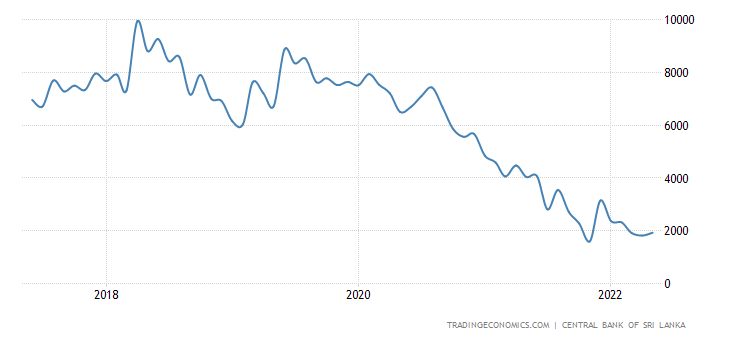 Source: CEIC, Central Bank of Sri Lanka
Source: CEIC, Central Bank of Sri Lanka
A steady influx of tourists would undoubtedly help aid the recovery of the disaster-hit country with its foreign exchange woes. However, the crisis' repercussions, along with the streak of violence and the imposition of emergency, are threatening an industry that has long proved to be a significant component of a viable economic solution to the country’s progress. Images of long queues of motorcycle taxis at service stations waiting for gasoline—a scarce commodity in the country at the moment—is adding to the anxiety of tourists planning to visit the country in the coming months. Additionally, the Sri Lankan government imposed a ban on the social media giants— Meta and Twitter on 3 April, 2020—a step which increased concerns amongst the tourists about the country's future as their vacation destination.
Tourism is slated to play a crucial role in the resurrection of the country’s distressed economic condition, by attracting foreign exchange earnings and complementing the growth rate in the years to come. With the country looking for a way out of the mess it finds itself in on the economic front, the tourism sector will be expected to revive its fortunes, which in the past had been a source of much glory for the Sri Lankan economy.
The author acknowledges Nikhil Joshi at Shiv Nadar University, for his research inputs on this essay.
The views expressed above belong to the author(s). ORF research and analyses now available on Telegram! Click here to access our curated content — blogs, longforms and interviews.








 PREV
PREV

